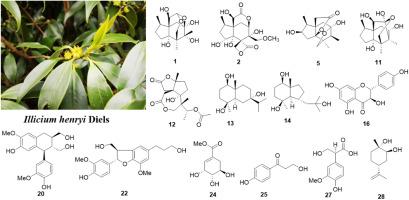茴香果实的化学成分及其化学分类意义
IF 2
4区 生物学
Q4 BIOCHEMISTRY & MOLECULAR BIOLOGY
引用次数: 0
摘要
通过植物化学研究,鉴定出31种化合物,包括14种倍半萜类化合物(1-14)、2种黄酮类化合物(15-16)、7种木脂素(17-23)、1种莽草酸衍生物(24)、1种苯丙酸衍生物(25)、2种酚类化合物(26和27)、3种单萜类化合物(28-30)和1种C13去倍半萜类化合物(31)。这些化合物的结构通过1H和13C核磁共振谱分析和与先前文献数据的比较得到了阐明。其中化合物2 ~ 4、8、9、14、15、17 ~ 19、21和23 ~ 31为首次从鸢尾属植物中分离得到,其中化合物15、17 ~ 19、23、25 ~ 28、30和31为首次从鸢尾属植物中分离得到。此外,本文还讨论了这些化合物的化学分类意义。本文章由计算机程序翻译,如有差异,请以英文原文为准。

Chemical constituents from the fruits of Illicium henryi Diels and their chemotaxonomic significance
A phytochemical investigation of Illicium henryi fruits resulted in the identification of 31 compounds, including fourteen sesquiterpenoids (1–14), two flavonoids (15–16), seven lignans (17–23), one shikimic acid derivative (24), one phenylpropanoid derivative (25), two phenolic compounds (26 and 27), three monoterpenoids (28–30), and one C13 norsesquiterpenoid (31). The structures of these compounds were elucidated through 1H and 13C NMR spectroscopic analyses and comparison with previously documented data. Twenty compounds (2–4, 8, 9, 14, 15, 17–19, 21, and 23–31) were isolated from I. henryi for the first time, and among them, eleven compounds (15, 17–19, 23, 25–28, 30, and 31) had never been previously isolated from any Illicium species. Additionally, this article discusses the chemotaxonomic significance of these compounds.
求助全文
通过发布文献求助,成功后即可免费获取论文全文。
去求助
来源期刊

Biochemical Systematics and Ecology
生物-进化生物学
CiteScore
3.00
自引率
12.50%
发文量
147
审稿时长
43 days
期刊介绍:
Biochemical Systematics and Ecology is devoted to the publication of original papers and reviews, both submitted and invited, in two subject areas: I) the application of biochemistry to problems relating to systematic biology of organisms (biochemical systematics); II) the role of biochemistry in interactions between organisms or between an organism and its environment (biochemical ecology).
In the Biochemical Systematics subject area, comparative studies of the distribution of (secondary) metabolites within a wider taxon (e.g. genus or family) are welcome. Comparative studies, encompassing multiple accessions of each of the taxa within their distribution are particularly encouraged. Welcome are also studies combining classical chemosystematic studies (such as comparative HPLC-MS or GC-MS investigations) with (macro-) molecular phylogenetic studies. Studies that involve the comparative use of compounds to help differentiate among species such as adulterants or substitutes that illustrate the applied use of chemosystematics are welcome. In contrast, studies solely employing macromolecular phylogenetic techniques (gene sequences, RAPD studies etc.) will be considered out of scope. Discouraged are manuscripts that report known or new compounds from a single source taxon without addressing a systematic hypothesis. Also considered out of scope are studies using outdated and hard to reproduce macromolecular techniques such as RAPDs in combination with standard chemosystematic techniques such as GC-FID and GC-MS.
 求助内容:
求助内容: 应助结果提醒方式:
应助结果提醒方式:


